A Re-envisioned Approach to Traditional Landscaping
Most landscapes today feature shrubs and turfgrass, which is a wasteland for bees, butterflies, hummingbirds, and other important pollinators. Insects need flowers for nectar and pollen. Whether creating a new planting space or adding plants to an existing landscape, you can make a big impact by creating spaces that attract and nurture the smallest of our wildlife friends. Planting with a Purpose is a new Riverbanks initiative designed to inspire individuals, businesses and communities to add much needed pollinator habitat into everyday landscapes.
Why Pollinators? Why Now?
Pollinators contribute to one in every three bites of food we eat. They are vital to the food sources of both humans and wildlife. Habitat loss, insecticides, large scale farming and changes in climate patterns are all contributing to a significant loss in pollinators.
- Providing a Pollinator Paradise
- Choose a sunny area of your yard that receives at least 6 hours of sun per day.
- The area doesn’t have to be large. A plot as small as 3' x 3' will work.
- Instead of creating a new space, you can add plants to an existing landscape. It is as easy as digging some holes and placing the plants in them.
- A great area for pollinator-friendly plants could be the front of a foundation bed. Extend the area about two feet, and you can provide a buffet for bees and butterflies!
- Perennial Care for Pollinator-Friendly Gardens
- In the first year, provide supplemental water for your new plants.
- Mulching with leaves raked from other areas of the yard will help retain moisture, providing habitat for insects in the winter and for breeding. Heavy straw or hardwood mulch can prevent insects from getting to the soil.
- Wait to cut back plants until mid-spring. Many insects spend winter in the stems of plants. When you see new spring growth emerging, it’s time to cut back the brown tops of last year’s plants.
- Planting for Pollinators
- Clear the new space of weeds or turfgrass.
- Add a small amount of compost and mix in well. Two to three inches of compost will help sandy soil retain water and break up clay soil. Avoid using too much compost as most pollinator plants prefer a lean soil.
- If planting several of the same plants, group them together.
- Make sure to break up the root ball of your new plants.
- Avoid planting too deep or too shallow. The soil line of your potted plant should be even with the top of the soil.
Plants can do more than just beautify a yard—they can help save pollinators!
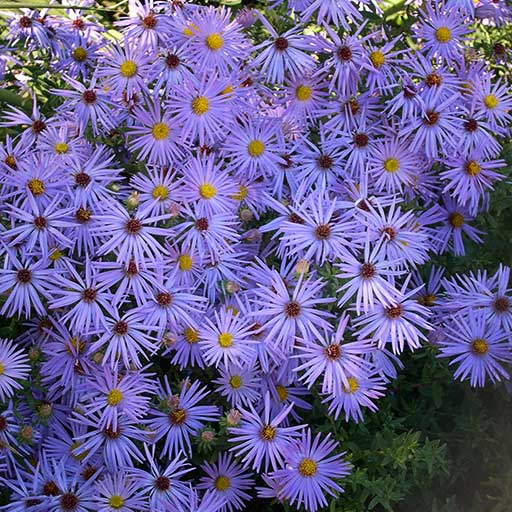
Aster (Symphyotrichum species)
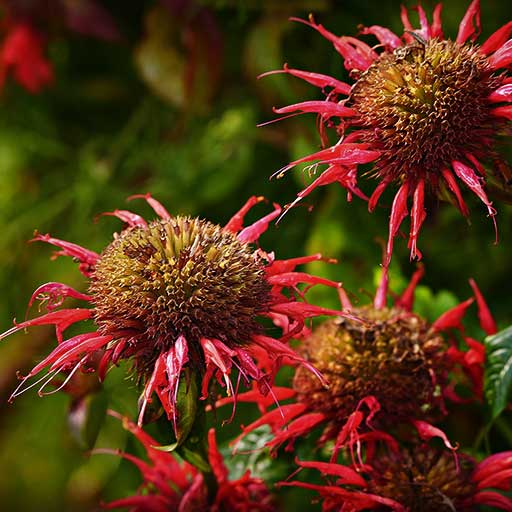
Beebalm (Monarda species)
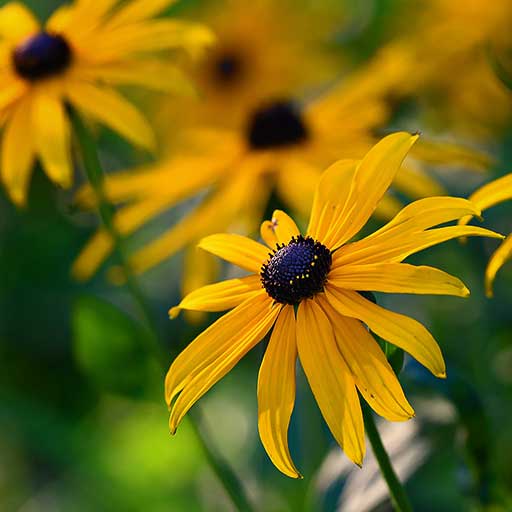
Black-eyed Susan (Rudbeckia species)
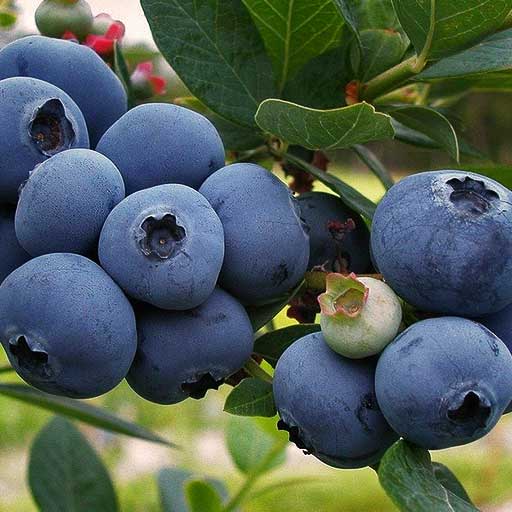
Blueberry (Vaccinium species)
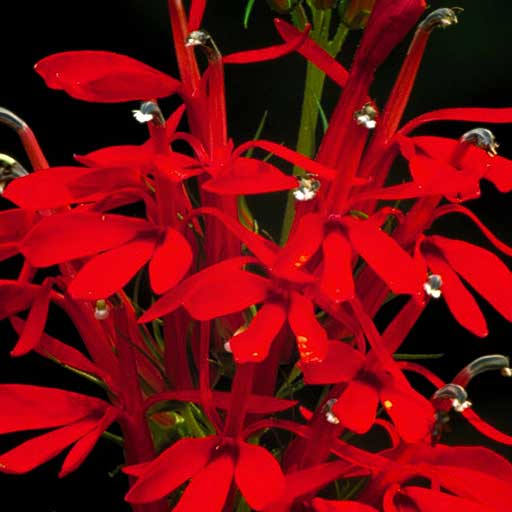
Cardinal Flower (Lobelia species)
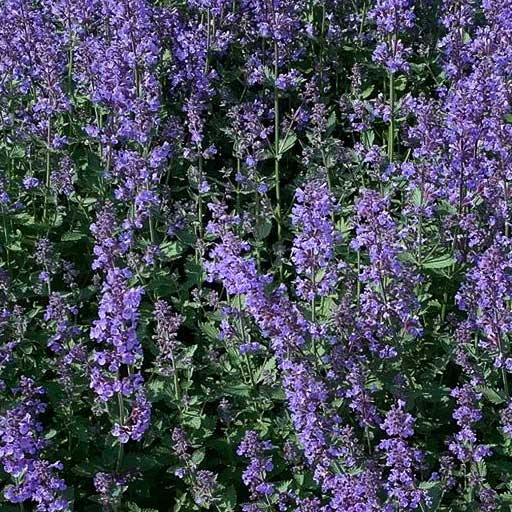
Catmint (Nepeta species)
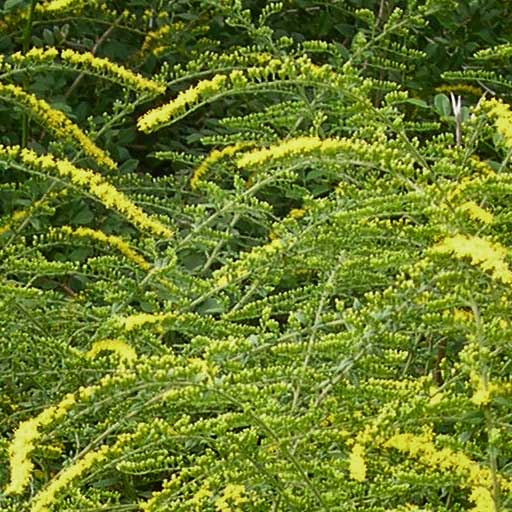
Goldenrod (Solidago species)
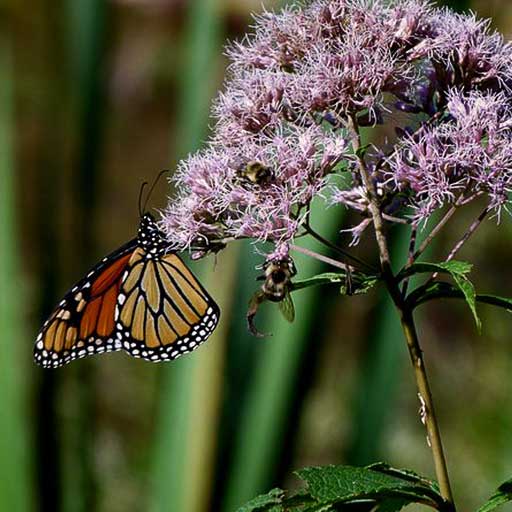
Joe-pye-weed (Eutrochium species)
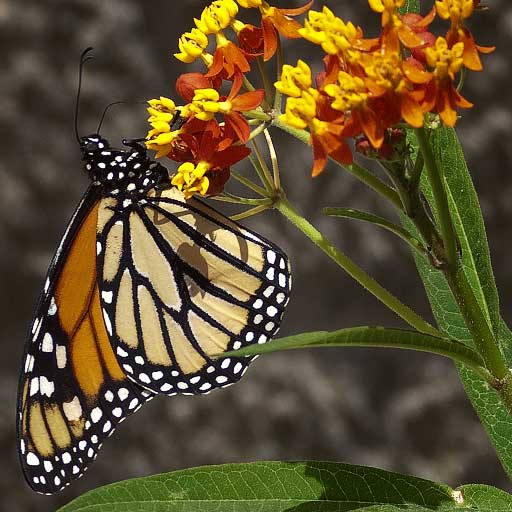
Milkweed (Asclepias species)
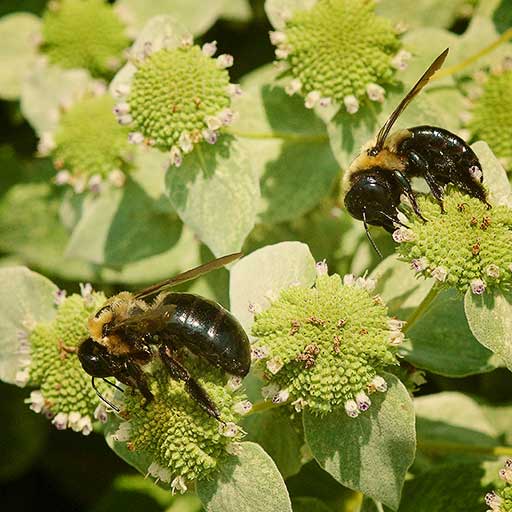
Mountain mint (Pyncanthemum species)
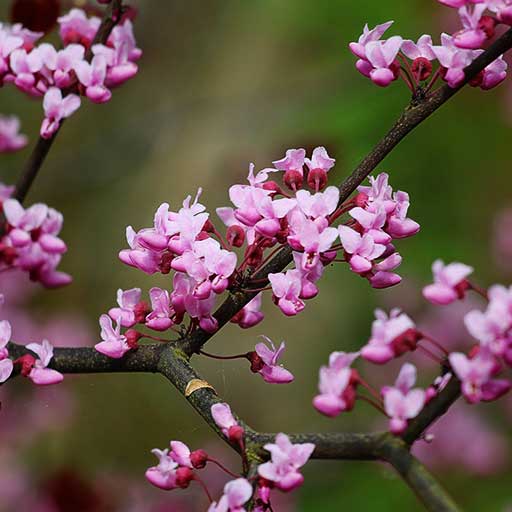
Redbud (Cercis species)
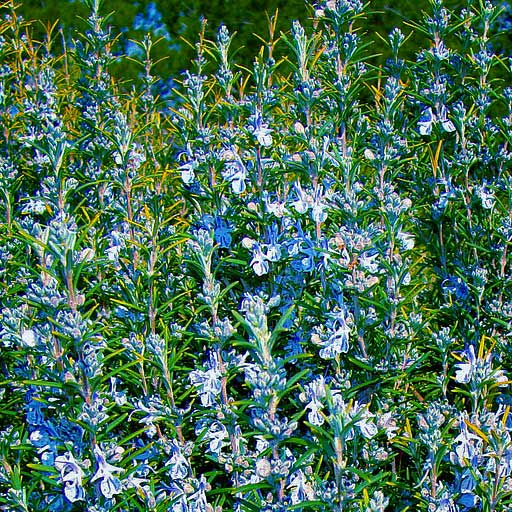
Rosemary (Rosmarinus species)
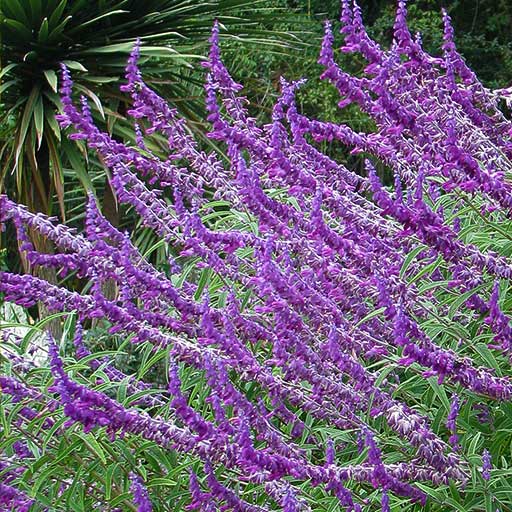
Sage (Salvia species)
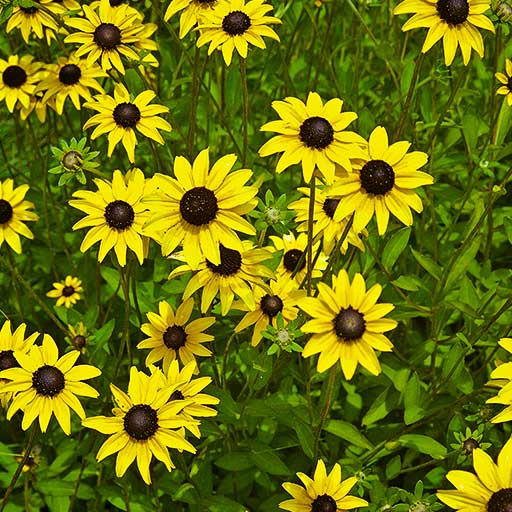
Sunflowers (Helianthus species)
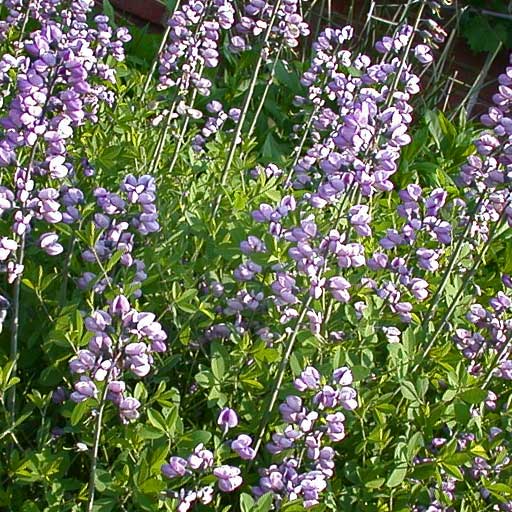
Wild Indigo (Baptisia species)
Aster (Symphyotrichum species)
Asters are daisy-like plants that flower in late summer and early fall. They are a great late season source of nectar and pollen for pollinators. Plant in full sun, paying attention to the mature height of the plant for placement. Aster foliage should be cut back in late winter (March in SC) just as new foliage begins to emerge. Cut back to 4".
- Recommended selections:
- Symphyotrichum laeve (Smooth blue aster) — height 2'–3', spread 3'–4'
- S. novae-angliae (New England aster) — height 3'–6', spread 2'–3'
- S. novi-belgii (New York aster) — height 3'–5', spread 3'
- S. oblongifolium (‘Raydon’s Favorite’ Aromatic aster) — height 3'
- S. laevis (‘Blue Bird’ Bluebird Smooth blue aster) — height 4'
- S. novae-angliae (‘Purple Dome’ New York aster) — height 18"
- Attracts:
- Bumble bees
- Mining bees
- Polyester bees
- Long-horned bees
Beebalm (Monarda species)
Beebalm makes up a large group of perennials with various species and cultivars. All are great pollinator plants and attract different pollinators depending on the species. Beebalm prefers full sun and flowers in mid-summer. While the red-flowered bee balm is most seen in gardens, try to plant one of the natives listed below to attract more diverse pollinators.
- Recommended selections:
- Monarda fistulosa (Wild bergamot) — height 2'–5'
- Monarda punctata (Spotted bee balm) — height 3'
- Monarda (‘Jacob Cline’ Scarlet bee balm) — height 3'–5'
- Attracts:
- Bees
- Hummingbirds
- Moths
- Butterflies
Black-eyed Susan (Rudbeckia species)
Black-eyed susans are a sun-loving perennial and a favorite of many pollinators. Different species range in height from one foot to six feet. The plants are heat and drought tolerant and grow easily from seed. Leave the stems and seed heads after flowering to encourage seeding in the garden and to provide food for birds. Cut back the stems in the spring when new foliage emerges. The bee Andrena rudbeckiae specializes in pollinating black-eyed susans.
- Recommended selections:
- Rudbeckia hirta (Black-eyed susan) — height 2'–3'
- Rudbeckia laciniata (Cutleaf coneflower) — height 5'–8'
- Rudbeckia maxima (Great coneflower) — height — plant 2', flower stalk 5'–7'
- Rudbeckia fulgida var. sullivantii (‘Goldsturm’ Black-eyed susan) — height 2'–3'
- Rudbeckia fulgida var. fulgida (Black-eyed susan) — height 24"–30"
- Rudbeckia triloba (Three-leaved coneflower) — height 2'–3'
- Rudbeckia subtomentosa (‘Henry Eilers’ Sweet coneflower) — height 4'–5'
- Attracts:
- Bees
- Butterflies
Blueberry (Vaccinium species)
Blueberries are a great plant to grow for pollinators as well as providing yummy fruit for the kitchen. For the best results, plant southern highbush blueberries in SC. This group of plants require fewer chilling hours and better heat tolerance than other types of blueberries. Make sure to plant in full sun, and in heavy clay soils make sure not to overwater. You may need to protect your fruit with nets as blueberries are popular with birds and other small animals.
Cardinal Flower (Lobelia species)
Lobelias are very showy perennials and produce large amounts of nectar. Although bees cannot see the red cardinal flower, bumble bees are attracted to the blue lobelias. Lobelias can be found naturally in areas with moist soil; however, they adapt well to a garden setting with some additional water. These plants may prefer a little afternoon shade in the South and may benefit from being in the shadow of a taller plant.
- Recommended selections:
- Lobelia cardinalis (Cardinal flower) — height 2'–4'
- Lobelia siphilitica (Great Blue Lobelia) — height 2'–3'
- Attracts:
- Butterflies for nectar
- Bumble bees to blue lobelia (bees do not see red)
- Hummingbirds
Catmint (Nepeta species)
Catmint is an attractive spring flowering perennial. Although similar in name, and a close relative to catnip, catmint is actually quite different. Catmint is not psychoactive to cats and will not encourage them to visit your garden. The blue flowers of catmint are a huge draw for honey bees and bumble bees. This plant loves it hot and dry, so it makes a great addition to the garden if you are a lazy waterer. Cut back dead foliage in the spring when new growth emerges.
- Recommended selections:
- Nepeta racemosa (‘Walker’s Low’ Dwarf catmint) — height 24"–30"
- Attracts:
- Bees
Goldenrod (Solidago species)
Goldenrod is a fall blooming perennial often confused with the dreaded ragweed that causes many seasonal allergies. This sun-loving native perennial is pollinated by insects. Most allergy causing plants are wind pollinated. Goldenrod is a spreading plant so a little goes a long way. Solidago, the genus for goldenrod, means “to make whole or heal,” and it has been used in traditional medicine to treat inflammation and urinary conditions. Once goldenrod has flowered in the fall, leave the stems for insects to nest in over winter. Cut back dead stems and foliage in spring as new growth emerges.
- Recommended selections:
- Solidago shortii (‘Solar Cascade’ Short’s goldenrod) — height 2'–3'
- Solidago rugosa (‘Fireworks’ Rough-stemmed goldenrod) — height 3'–4'
- Solidago sphacelata (‘Golden Fleece’ Autumn goldenrod) — height 18"–24"
- Attracts:
- Bees
- Soldier beetles
- Solitary wasps
Joe-pye-weed (Eutrochium species)
Joe-pye-weed is also known as queen of the meadow as it reigns supreme with large flower heads in the fall. This sun-loving perennial is found in sunny ditches and forest edges throughout the central and eastern US. Eutrochiums reach from 5-7 feet and should be planted in the back of the garden. This plant is a must have for pollinators. Many bee and butterfly species visit this plant for nectar, and birds will eat the seeds. Cut back the dead stems as new foliage emerges in the spring.
- Recommended selections:
- Eutrochium fistulosum (Hollow joe-pye-weed) — height 5'–8'
- Eutrochium maculatum (‘Gateway’ Spotted joe-pye-weed) — height 5'–6'
- Eutrochium dubium (‘Little Joe’ Coastal Plain joe-pye-weed) — height 4'–5'
- Attracts:
- Butterflies (host and nectar plant)
- Bees
Milkweed (Asclepias species)
Milkweed is an important plant for many pollinators. Monarch butterflies only lay eggs on the underside of milkweed leaves, which provide the necessary food source for their caterpillars. The caterpillars will consume the flowers and leaves of the plants before forming a chrysalis on the plant and later hatching an adult butterfly. Many other insects visit milkweed for the high sugar levels in the nectar.
Milkweed is notoriously difficult to transplant so plant young or via seed to encourage good growth. The plant must have full sun and is best planted in a large group to attract Monarchs. Growing from seed is somewhat challenging as a cold period may be required for best germination. It is recommended that gardeners not plant the tropical milkweed, Asclepias curassavica.
- Recommended selections:
- Asclepias tuberosa (Butterfly flower)
- Asclepias incarnata (Swamp milkweed)
- Attracts:
- Monarch butterflies
- Sulphur butterflies
- Leafcutter bees
Mountain mint (Pyncanthemum species)
Mountain mint is a perennial with aromatic foliage related to beebalm. This plant is a pollinator magnet. Because of the strong odor of the plant, it is resistant to deer grazing. The two major pyncanthemums differ in appearance. Pycnanthemum flexuosum has conspicuous, dense white flowers. Pycnanthemum muticum has insignificant flowers but silver-dusted, leaf-like bracts which give the plant a white glowing look.
- Recommended selections:
- Pycnanthemum flexuosum (Appalachian mountain mint) — height 2'–3'
- Pycnanthemum muticum (Clustered mountain mint) — height 2'–3'
- Attracts:
- Bees
- Wasps
- Flies
- Beetles
- Butterflies
Redbud (Cercis species)
Redbud is a small understory tree that is a perfect size for any yard. The pink flowers of redbud appear before the foliage in early spring. As one of the earliest flowering plants it is an important source of pollen for many bee species. Situate this small tree in full sun to part shade and provide supplemental water throughout the first year of growth. There are many new cultivars of redbud available in nurseries.
- Recommended selections:
- Cercis canadensis (Redbud) — height 20', spread 15'
- Attracts:
- Bees
- Host plant for some butterflies
Rosemary (Rosmarinus species)
Rosemary is typically grown as an herb but can be so much more in the landscape. As an evergreen, rosemary can make a great low maintenance foundation plant or a short hedge. The sporadic blue flowers are a draw for bees throughout many seasons. Hailing from the Mediterranean, it is important to provide good drainage when planting rosemary. Little maintenance is required to keep this shrub looking good. Plant in full sun and prune only for culinary use or to remove dead wood.
- Recommended selections:
- Rosmarinus officinalis (‘Barbeque’ Upright rosemary) — height 4'–6'
- Rosmarinus officinalis (‘Chef’s Choice’ rosemary) — height 18"–24"
- Rosmarinus officinalis (‘Tuscan blue’ Upright rosemary) — height 6'
- Rosmarinus officinalis (Prostratus Group Prostrate rosemary) — height 2', spread 6'–8'
- Attracts:
- Bees
Sage (Salvia species)
Salvia encompasses a huge group of plants known for their culinary, medicinal and ornamental use. There are perennial and annual salvias for the garden, but for pollinator purposes, it is best to use perennials. Some salvias are small and tend to stay tidy in the garden. Others will spread and form a large flowering mass. Make sure to choose the correct salvia for your setting. Plant in full sun and cut back dead stems and foliage as new growth emerges in the spring.
- Recommended selections:
- Salvia guaranitica (‘Black and Blue’ Anise-scented sage) — height 2'–5'
- Salvia guaranitica (‘Sapphire’ Anise-scented sage) — height 4'
- Salvia officinalis (Common sage) — height 6"–12"
- Salvia elegans (Pineapple sage) — height 3'–4'
- Salvia leucantha (Mexican bush sage) — height 3'–4'
- Attracts:
- Bees
- Hummingbirds
Sunflowers (Helianthus species)
Sunflowers are a ubiquitous sign of warm weather. Many different species and cultivars can be found throughout the US. Both perennial sunflowers and the more common annual sunflowers are a great addition to the garden and attract pollinators. Annual sunflowers will require new planting each spring whereas perennial sunflowers will return year after year. Be careful when choosing annual sunflowers to avoid any varieties which are pollen free. Sugar content in the nectar is very high in sunflowers. Perennial sunflower varieties are readily available in nurseries, but annual sunflowers will probably require starting from seed. Sunflowers need full sun and may require staking.
- Recommended selections:
- Helianthus angustifolius (Swamp sunflower) — height 5'–7', spread 3'–5'
- Helianthus maximiliani (Maximillian’s sunflower) — height 7', spread 3'–4'
- Helianthus (‘Lemon Queen’ Lemon Queen sunflower) — height 3'–4', spread 3'–4'
- Helianthus salicifolius (‘First Light’ Willowleaf sunflower) — height 3'–4', spread 3'–4'
- Attracts:
- Bees (many species)
- Host plant for some butterfly species
Wild Indigo (Baptisia species)
Baptisia is a native perennial with a short flowering time in the spring. This plant is readily available at nurseries and transplants well. Situate in full sun for a more robust plant and increased flowering. Its sturdy stems hold the flowers well above the foliage. Insects with long tongues can access the nectar and pollen.
- Recommended selections:
- Baptisia australis (Blue wild indigo) — height 3'–4', spread 3'–4'
- Baptisia alba (White wild indigo) — height 2'–4', spread 2'–3'
- Attracts:
- Host plant for several butterfly species

